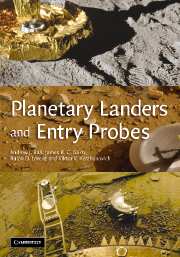Book contents
- Frontmatter
- Contents
- Preface
- Acknowledgements
- List of acronyms and abbreviations
- PART I Engineering issues specific to entry probes, landers or penetrators
- 1 Mission goals and system engineering
- 2 Accommodation, launch, cruise and arrival from orbit or interplanetary trajectory
- 3 Entering atmospheres
- 4 Descent through an atmosphere
- 5 Descent to an airless body
- 6 Planetary balloons, aircraft, submarines and cryobots
- 7 Arrival at a surface
- 8 Thermal control of landers and entry probes
- 9 Power systems
- 10 Communication and tracking of entry probes
- 11 Radiation environment
- 12 Surface activities: arms, drills, moles and mobility
- 13 Structures
- 14 Contamination of spacecraft and planets
- PART II Previous atmosphere/surface vehicles and their payloads
- PART III Case studies
- Appendix Some key parameters for bodies in the Solar System
- Bibliography
- References
- Index
4 - Descent through an atmosphere
Published online by Cambridge University Press: 12 August 2009
- Frontmatter
- Contents
- Preface
- Acknowledgements
- List of acronyms and abbreviations
- PART I Engineering issues specific to entry probes, landers or penetrators
- 1 Mission goals and system engineering
- 2 Accommodation, launch, cruise and arrival from orbit or interplanetary trajectory
- 3 Entering atmospheres
- 4 Descent through an atmosphere
- 5 Descent to an airless body
- 6 Planetary balloons, aircraft, submarines and cryobots
- 7 Arrival at a surface
- 8 Thermal control of landers and entry probes
- 9 Power systems
- 10 Communication and tracking of entry probes
- 11 Radiation environment
- 12 Surface activities: arms, drills, moles and mobility
- 13 Structures
- 14 Contamination of spacecraft and planets
- PART II Previous atmosphere/surface vehicles and their payloads
- PART III Case studies
- Appendix Some key parameters for bodies in the Solar System
- Bibliography
- References
- Index
Summary
Overview and fundamentals
The descent through the atmosphere is often the only part of a planetary probe mission, as for example the Pioneer Venus and Galileo probes; on other missions it is just the last stage of a long journey prior to surface operations. The key parameters are the altitude of deployment – usually the altitude at which the vehicle ends its entry phase, as defined by some Mach number threshold – and the required duration of descent.
The duration of descent for an atmospheric probe is often dictated by an external constraint on the mission duration, such as the visibility window of a flyby spacecraft that is to act as a communications relay. This imposes an upper limit on the descent duration – it may be that (as for the Huygens probe) some part of that mission window is desired to be spent on the surface.
The instantaneous rate of descent (and thus the total duration) is determined at steady state by the balance between weight and drag. The former is simply mass times gravity; the latter depends on ambient air density, the drag area of the vehicle and any drag-enhancement device such as a parachute or ballute. The drag area is usually expressed as a reference area and a drag coefficient. Often these parameters and the mass are lumped together into the so-called ballistic coefficient β.
Often the dynamic pressure of descent is used to force ambient air into sampling instruments such as gas chromatographs.
- Type
- Chapter
- Information
- Planetary Landers and Entry Probes , pp. 36 - 46Publisher: Cambridge University PressPrint publication year: 2007

